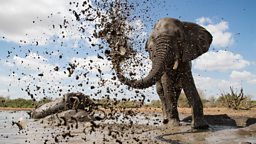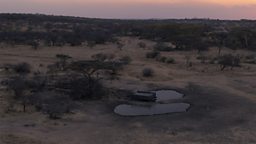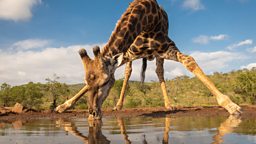The Waterhole perspective

Ring-side seats at the best show in the natural world
In the African savannah there’s no single place more visited by a variety of wildlife than a waterhole. Animals of all shapes and sizes come here to drink, eat and socialise but filming an immersive, front row experience of life at a waterhole was going to be no easy task. For many species, drinking from a water source is when they are at their most vulnerable from predation so getting a close and intimate view of them, in the most discreet way possible, became the main challenge of the series. It was such a big challenge, it called for two solutions.
a plan was devised to blitz the waterhole area with up to 20 cameras
The Fixed Rig Cameras
Combining the expertise of the Springwatch team and a specialist camera company that has experience of setting up fixed rig systems in remote locations for survival programmes, a plan was devised to blitz the waterhole area with up to 20 cameras. Fibre optic cable was run from the waterhole site back to a tented basecamp 250 metres away so that there could be a “live feed” and so the cameras could be operated with minimal disturbance to wildlife.

The Filming Hide
Alongside the fixed rigged cameras positioned around the waterhole area, one of the most unique features of the filming set up was a specially built filming hide. Half-submerged into the waterhole itself and built to, over time, blend seamlessly into the surrounding landscape; the hide would give camera operators and the presenters a chance to use different filming equipment such as super slow-motion and thermal imaging technology to bring a brand-new perspective on wildlife and place the audience right in the middle of the action.
eye-to-eye perspective is becoming increasingly popular in Africa
The Inspiration for the Waterhole hide
Photographers around the world often used filming hides to capture great images and the trend for a low angle, eye-to-eye perspective is becoming increasingly popular in Africa. Across the continent reserves and lodges have been building waterhole hides to enable people to capture a once-in-a-lifetime shot and many of these have been designed by Shem Compion, a photographer and hide builder. Inspired by Shem’s work, the 大象传媒 Studios Natural History Unit and Mwiba Wildlife Reserve set out to build the world’s first manmade waterhole with a built-in fixed rig camera system and half-submerged photographic hide.

...they could smell the buffalo herd, were splashed by washing elephants, saw right into the eyes of a warthog and could feel the scale of a towering giraffe.
A Unique View
One of the most immersive aspects of Waterhole: Africa’s Animal Oasis is how the show’s cameras bring viewers closer to African wildlife than ever before. Because of the hide, the film crew were lucky enough to get even closer: they could smell the buffalo herd, were splashed by washing elephants, saw right into the eyes of a warthog and could feel the scale of a towering giraffe. The hide and waterhole at Mwiba Reserve are permanent structures built to benefit future generations of animals and photographers alike - and if you’re at home and want to experience of this unique view for yourself you can watch Waterhole: Africa’s Animal Oasis on iPlayer now.
